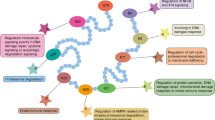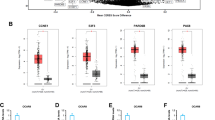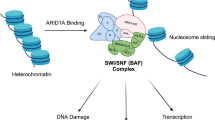Abstract
Ovarian cancer is one of the most lethal gynecologic malignancies worldwide, with the 5-year survival is less than 50%. Although some clinical achievements have been achieved, the overall survival rate has remained unchanged over the past 20 years. Therefore, it is necessary and urgent to develop the potential modifiers and therapeutic approach to improve the overall survival rate in ovarian cancer patients. RBCK1 is an RING protein E3 ubiquitin ligase, which was revealed to involve in the progression of several cancers through its ubiquitination function. In this research, we report that RBCK1 expression is significantly elevated in human ovarian cancer and strongly associated with poor patients’ prognosis. RBCK1 deficiency induces cell apoptosis and inhibits cell proliferation and migration in ovarian cancer cells. In terms of molecular mechanism, we report that RBCK1 interacts with PTEN and promotes PTEN degradation in K48-linked ubiquitination. Our study suggests a new and interesting regulatory mechanism that RBCK1 facilitates PTEN degradation, which could be a new potential therapeutic target for ovarian cancer treatment.






Similar content being viewed by others
Data availability
The datasets used and/or analyzed during the current study are available from the corresponding author on reasonable request.
References
Gaona-Luviano P, Medina-Gaona LA, Magana-Perez K. Epidemiology of ovarian cancer. Chin Clin Oncol. 2020;9(4):47. https://doi.org/10.21037/cco-20-34.
Penyige A, Marton E, Soltesz B, Szilagyi-Bonizs M, Poka R, Lukacs J, et al. Circulating miRNA profiling in plasma samples of ovarian cancer patients. Int J Mol Sci. 2019;20(18):4533. https://doi.org/10.3390/ijms20184533.
Kossai M, Leary A, Scoazec JY, Genestie C. Ovarian cancer: a heterogeneous disease. Pathobiology. 2018;85(1–2):41–9. https://doi.org/10.1159/000479006.
Zachariae H, Hansen HE, Sogaard H, Olsen TS. Kidney biopsies in methotrexate-treated psoriatics. Dermatologica. 1990;181(4):273–6. https://doi.org/10.1159/000247821.
Huang YW. Association of BRCA1/2 mutations with ovarian cancer prognosis: an updated meta-analysis. Medicine (Baltimore). 2018;97(2): e9380. https://doi.org/10.1097/MD.0000000000009380.
Eisenhaber B, Chumak N, Eisenhaber F, Hauser MT. The ring between ring fingers (RBR) protein family. Genome Biol. 2007;8(3):209. https://doi.org/10.1186/gb-2007-8-3-209.
Marin I, Lucas JI, Gradilla AC, Ferrus A. Parkin and relatives: the RBR family of ubiquitin ligases. Physiol Genomics. 2004;17(3):253–63. https://doi.org/10.1152/physiolgenomics.00226.2003.
Gustafsson N, Zhao C, Gustafsson JA, Dahlman-Wright K. RBCK1 drives breast cancer cell proliferation by promoting transcription of estrogen receptor alpha and cyclin B1. Cancer Res. 2010;70(3):1265–74. https://doi.org/10.1158/0008-5472.CAN-09-2674.
Liu ML, Zang F, Zhang SJ. RBCK1 contributes to chemoresistance and stemness in colorectal cancer (CRC). Biomed Pharmacother. 2019;118: 109250. https://doi.org/10.1016/j.biopha.2019.109250.
Yu S, Dai J, Ma M, Xu T, Kong Y, Cui C, et al. RBCK1 promotes p53 degradation via ubiquitination in renal cell carcinoma. Cell Death Dis. 2019;10(4):254. https://doi.org/10.1038/s41419-019-1488-2.
Li J, Yen C, Liaw D, Podsypanina K, Bose S, Wang SI, et al. PTEN, a putative protein tyrosine phosphatase gene mutated in human brain, breast, and prostate cancer. Science. 1997;275(5308):1943–7. https://doi.org/10.1126/science.275.5308.1943.
Martins FC, Couturier DL, Paterson A, Karnezis AN, Chow C, Nazeran TM, et al. Clinical and pathological associations of PTEN expression in ovarian cancer: a multicentre study from the Ovarian Tumour Tissue Analysis Consortium. Br J Cancer. 2020;123(5):793–802. https://doi.org/10.1038/s41416-020-0900-0.
Maehama T, Dixon JE. The tumor suppressor, PTEN/MMAC1, dephosphorylates the lipid second messenger, phosphatidylinositol 3,4,5-trisphosphate. J Biol Chem. 1998;273(22):13375–8. https://doi.org/10.1074/jbc.273.22.13375.
Stambolic V, Suzuki A, de la Pompa JL, Brothers GM, Mirtsos C, Sasaki T, et al. Negative regulation of PKB/Akt-dependent cell survival by the tumor suppressor PTEN. Cell. 1998;95(1):29–39. https://doi.org/10.1016/s0092-8674(00)81780-8.
Tamura M, Gu J, Matsumoto K, Aota S, Parsons R, Yamada KM. Inhibition of cell migration, spreading, and focal adhesions by tumor suppressor PTEN. Science. 1998;280(5369):1614–7. https://doi.org/10.1126/science.280.5369.1614.
Taylor H, Laurence ADJ, Uhlig HH. The role of pten in innate and adaptive immunity. Cold Spring Harb Perspect Med. 2019;9(12): a036996. https://doi.org/10.1101/cshperspect.a036996.
Xia Q, Ali S, Liu L, Li Y, Liu X, Zhang L, et al. Role of ubiquitination in PTEN cellular homeostasis and its implications in GB drug resistance. Front Oncol. 2020;10:1569. https://doi.org/10.3389/fonc.2020.01569.
Deng L, Meng T, Chen L, Wei W, Wang P. The role of ubiquitination in tumorigenesis and targeted drug discovery. Signal Transduct Target Ther. 2020;5(1):11. https://doi.org/10.1038/s41392-020-0107-0.
Shmueli A, Oren M. Life, death, and ubiquitin: taming the mule. Cell. 2005;121(7):963–5. https://doi.org/10.1016/j.cell.2005.06.018.
Popovic D, Vucic D, Dikic I. Ubiquitination in disease pathogenesis and treatment. Nat Med. 2014;20(11):1242–53. https://doi.org/10.1038/nm.3739.
Nakamura N. Ubiquitin system. Int J Mol Sci. 2018;19(4):1080. https://doi.org/10.3390/ijms19041080.
Tokunaga F. Linear ubiquitination-mediated NF-kappaB regulation and its related disorders. J Biochem. 2013;154(4):313–23. https://doi.org/10.1093/jb/mvt079.
Niu J, Shi Y, Iwai K, Wu ZH. LUBAC regulates NF-kappaB activation upon genotoxic stress by promoting linear ubiquitination of NEMO. EMBO J. 2011;30(18):3741–53. https://doi.org/10.1038/emboj.2011.264.
Chen Z, Thomas SN, Bolduc DM, Jiang X, Zhang X, Wolberger C, et al. Enzymatic analysis of PTEN ubiquitylation by WWP2 and NEDD4-1 E3 ligases. Biochemistry. 2016;55(26):3658–66. https://doi.org/10.1021/acs.biochem.6b00448.
Xia Q, Zhang H, Zhang P, Li Y, Xu M, Li X, et al. Oncogenic Smurf1 promotes PTEN wild-type glioblastoma growth by mediating PTEN ubiquitylation. Oncogene. 2020;39(36):5902–15. https://doi.org/10.1038/s41388-020-01400-1.
He L, Ingram A, Rybak AP, Tang D. Shank-interacting protein-like 1 promotes tumorigenesis via PTEN inhibition in human tumor cells. J Clin Investig. 2010;120(6):2094–108. https://doi.org/10.1172/JCI40778.
De Melo J, Lin X, He L, Wei F, Major P, Tang D. SIPL1-facilitated PTEN ubiquitination contributes to its association with PTEN. Cell Signal. 2014;26(12):2749–56. https://doi.org/10.1016/j.cellsig.2014.08.013.
Shi M, Whorton AE, Sekulovski N, Paquet M, MacLean JA, Song Y, et al. Inactivation of TRP53, PTEN, RB1, and/or CDH1 in the ovarian surface epithelium induces ovarian cancer transformation and metastasis. Biol Reprod. 2020;102(5):1055–64. https://doi.org/10.1093/biolre/ioaa008.
Zhao W, Han T, Li B, Ma Q, Yang P, Li H. miR-552 promotes ovarian cancer progression by regulating PTEN pathway. J Ovarian Res. 2019;12(1):121. https://doi.org/10.1186/s13048-019-0589-y.
Kinross KM, Montgomery KG, Kleinschmidt M, Waring P, Ivetac I, Tikoo A, et al. An activating Pik3ca mutation coupled with Pten loss is sufficient to initiate ovarian tumorigenesis in mice. J Clin Investig. 2012;122(2):553–7. https://doi.org/10.1172/JCI59309.
Acknowledgements
We thank all the members of Department of Gynaecology and Obstetrics, Affiliated Hospital of Xuzhou Medical University for sharing valuable material and research support.
Funding
This project were supported by Natural Science Foundation of Jiangsu Province (Grant No. BK20181152), China Postdoctoral Science Foundation funded project (Grant No. 237399), Scientific Research Project of Jiangsu Commission of Health (No. H2018015), Primary Research and Development Plan of Xuzhou Science and Technology (No. KC18146; No. KC20166), Research Project of Jiangsu Maternal and Child Health (No. F201903), Research and innovation program for Postgraduates in Colleges and universities in Jiangsu Province (No. KYCX20_2483), the Key Laboratory Foundation of Jiangsu Province (No. XZSYSKF2021017), and the Development Fund of Affiliated Hospital of Xuzhou Medical University (No. XYFM2021009).
Author information
Authors and Affiliations
Contributions
LH conceived and designed the study. GW, ZZ, and SS collected and wrote the manuscript. FY and ZJ helped to analyze the data. ZL and TW supervised the present study and had full access to all the data. LH confirm the authenticity of all the raw data. All authors read and approved the final manuscript.
Corresponding author
Ethics declarations
Conflict of interest
The authors declare that there is no conflict of interest.
Ethics approval
Approval was obtained from the ethics committee of University Affiliated Hospital of Xuzhou Medical University (No. XYFY2021-KL017-01). The procedures used in this study adhere to the tenets of the Declaration of Helsinki.
Additional information
Publisher's Note
Springer Nature remains neutral with regard to jurisdictional claims in published maps and institutional affiliations.
Supplementary Information
Below is the link to the electronic supplementary material.
Rights and permissions
About this article
Cite this article
Wang, G., Zhuang, Z., Shen, S. et al. Regulation of PTEN and ovarian cancer progression by an E3 ubiquitin ligase RBCK1. Human Cell 35, 896–908 (2022). https://doi.org/10.1007/s13577-022-00681-w
Received:
Accepted:
Published:
Issue Date:
DOI: https://doi.org/10.1007/s13577-022-00681-w




